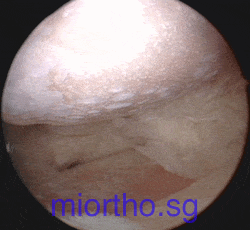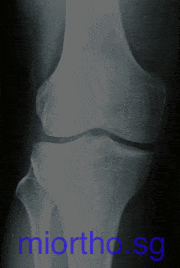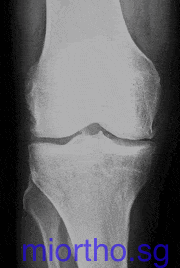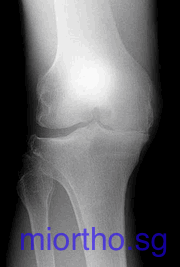Cartilage damage can sometimes affect large areas of the joint surfaces. This results in areas of bone rubbing on each other during joint movement, walking etc. Knee arthritis usually results in aching pain on walking or standing for long periods, and is often associated with swelling about the knee. Patients may notice that their knees are curving towards the direction of the worn out cartilage, because of the loss of cartilage thickness at that area.
The picture on the right demonstrates severe loss of cartilage over most of the knee joint. The only remaining cartilage are the spotty white patches. Most of the orange pink areas are exposed bone.

The three X-rays below were taken with the patient standing up. They show a gradual worsening of knee arthritis. The picture on the left shows a normal knee with a normal joint space between thigh and leg bones. This space is due to the fact that joint cartilage is transparent on X-ray. The picture in the middle shows how the space is narrow, the bony edges are irregular, and bone spurs are starting to form due to the wear and tear. The picture on the right demonstrates complete loss of joint cartilage, with bone touching bone.



The three X-rays below were taken with the patient standing up. They show a gradual worsening of knee arthritis. The picture on the left shows a normal knee with a normal joint space between thigh and leg bones. This space is due to the fact that joint cartilage is transparent on X-ray. The picture in the middle shows how the space is narrow, the bony edges are irregular, and bone spurs are starting to form due to the wear and tear. The picture on the right demonstrates complete loss of joint cartilage, with bone touching bone.
